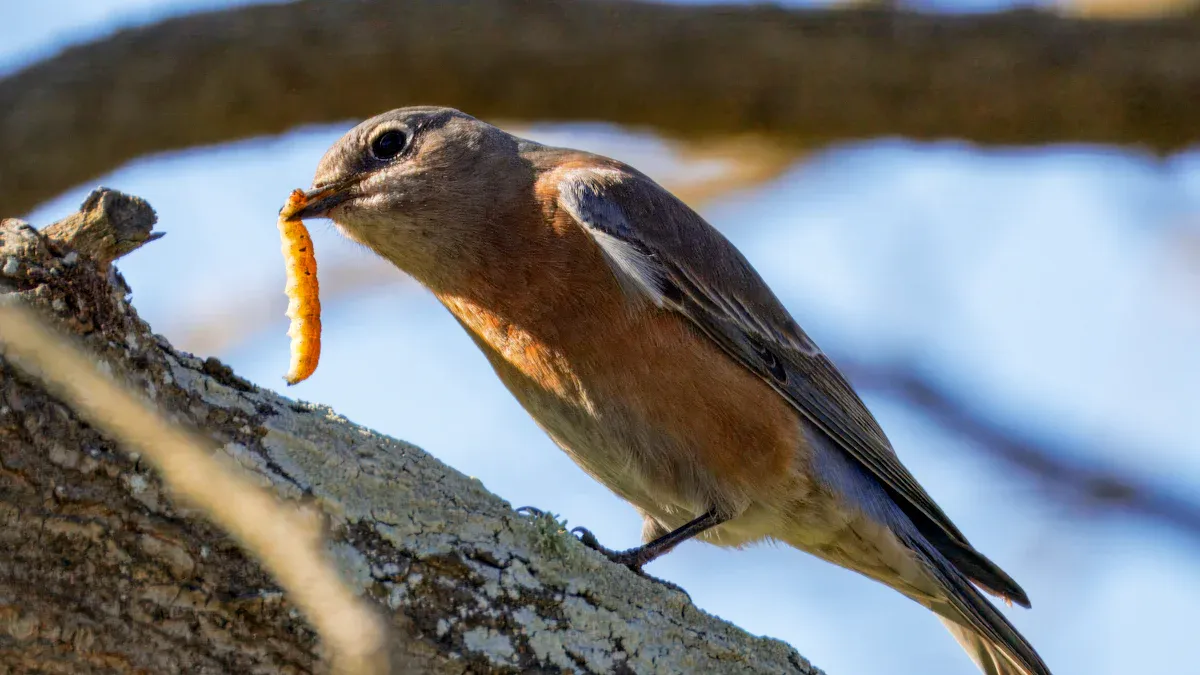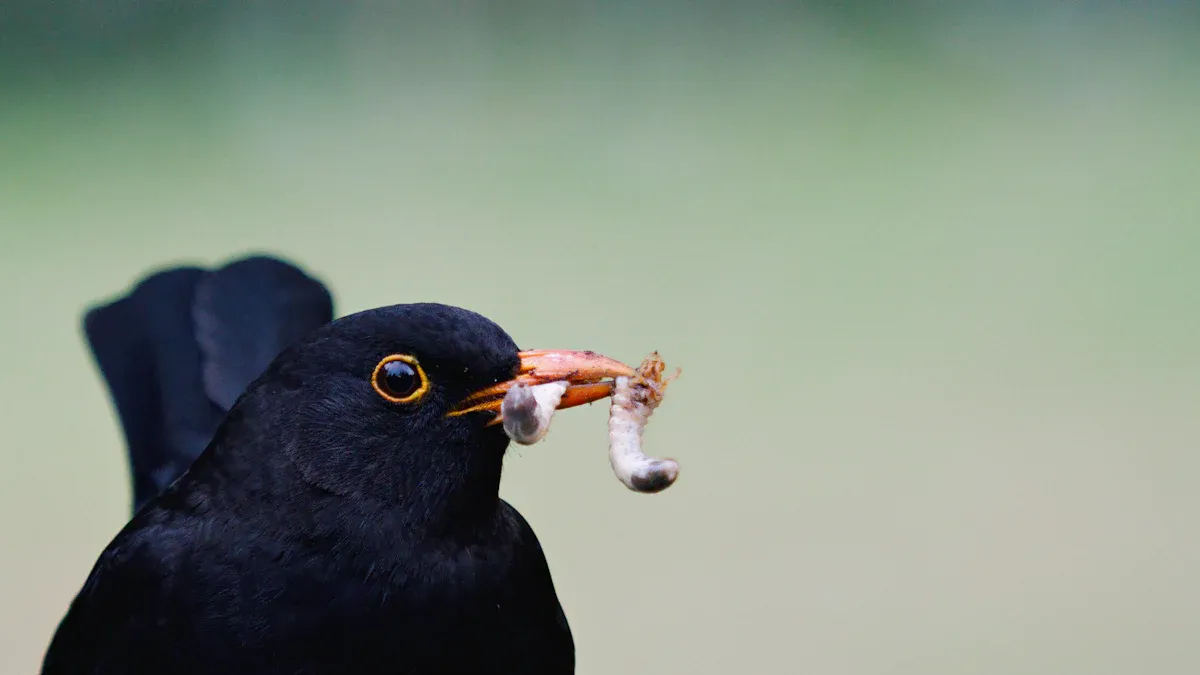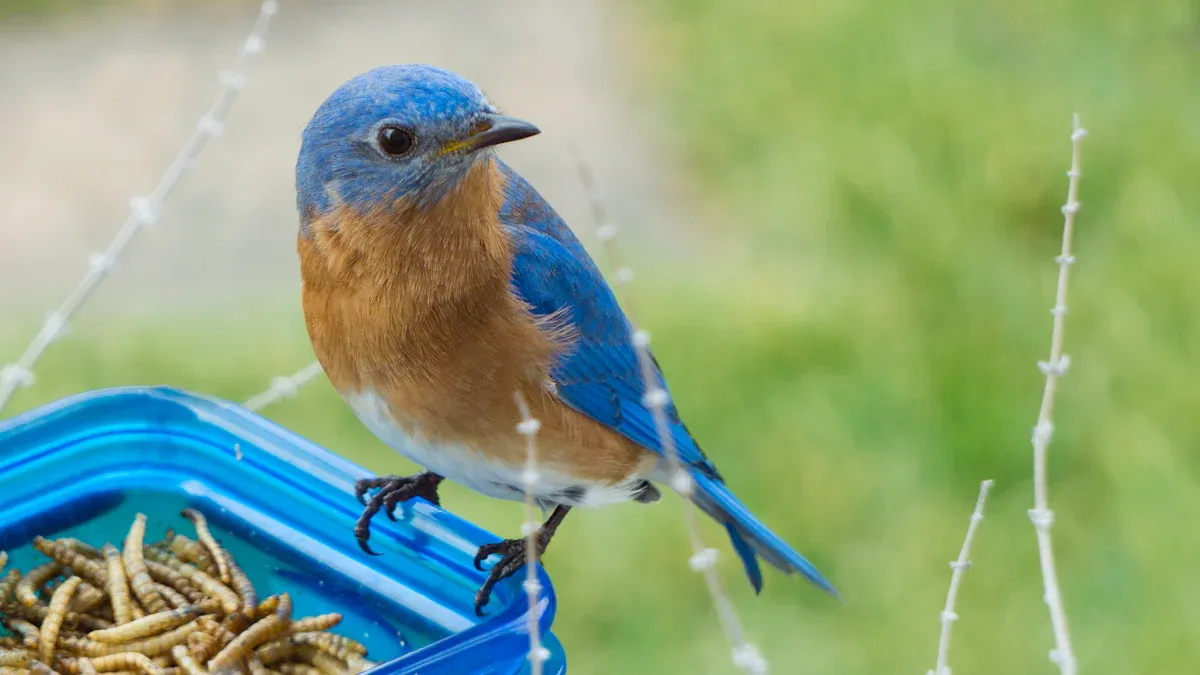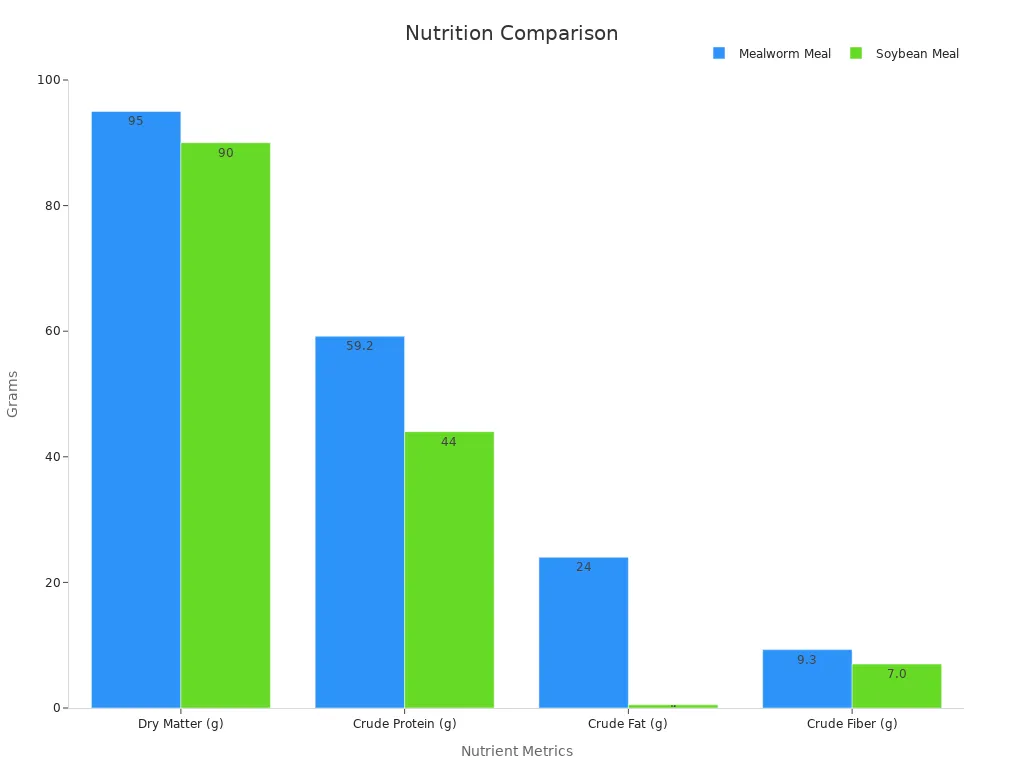
Mealworms pack a punch when it comes to bird nutrition. They’re loaded with protein, fat, and fiber, making them an ideal choice for boosting bird health. Dried mealworms, for example, contain up to 53% protein, 28% fat, and 6% fiber, offering a nutritionally dense option for bird feed mealworms. Birds thrive when mealworms are part of their diet, showing improved growth and digestibility compared to traditional feed sources.
Key Takeaways
- Mealworms are high in protein, with up to 53%. This helps birds grow and stay energetic.
- Adding mealworms to bird food improves energy, strength, and feathers. This is extra helpful in winter and breeding times.
- Combining mealworms with other foods makes a healthy diet. It brings many bird types and gives them needed nutrients.
Nutritional Composition of Bird Feed Mealworms

High Protein Content
Protein is the building block of life, and mealworms are packed with it. Birds need protein to grow, repair tissues, and stay active. Dried mealworms, for instance, contain up to 53% protein, making them one of the richest protein sources in bird feed. This high protein content supports muscle development and helps birds maintain their energy levels throughout the day.
Studies show that mealworms raised on different diets can have varying protein levels. For example, mealworms fed wheat-based substrates contain between 70% and 76% protein by dry weight. This makes them a reliable option for bird nutrition, especially when paired with other nutrient-rich foods.
| Type of Mealworm | Moisture | Lipid | Protein | Ash | Carbohydrate |
|---|---|---|---|---|---|
| Live Mealworms | 62% | 13% | 20% | 1.5% | 3.1% |
| Dried Mealworms | 5% | 28% | 53% | 4.1% | 8.5% |
Mealworms are a powerhouse of protein, and birds thrive when they’re part of their diet. Whether you’re feeding wild birds or pets, mealworms provide the protein boost they need to stay healthy and strong.
Rich in Essential Fatty Acids
Fatty acids are vital for birds, especially during colder months or breeding seasons. Mealworms are rich in essential fatty acids like linoleic acid, oleic acid, and palmitic acid. These fats help birds store energy, regulate body temperature, and maintain healthy skin and feathers.
The nutritional profile of mealworms can change based on their diet. For example, mealworms fed potato cuttings show a doubling of fat content, with an increase in saturated and mono-unsaturated fatty acids. This highlights how their diet impacts their nutritional value.
- Protein content ranges from 70% to 76% of dry weight.
- Fat content ranges from 6% to 12% of dry weight.
- Major fatty acids include:
- Linoleic acid (30-38%)
- Oleic acid (24-34%)
- Palmitic acid (14-17%)
Bird feed mealworms are an excellent source of fats that birds need to stay energized and vibrant. Adding them to your bird feed ensures your feathered friends get the nutrients they need to thrive.
Packed with Vitamins and Minerals
Mealworms aren’t just about protein and fat—they’re loaded with vitamins and minerals too. These nutrients play a key role in supporting a bird’s immune system, bone health, and overall vitality.
Yellow mealworms contain essential minerals like magnesium, zinc, and iron. They also provide copper and manganese, which are crucial for metabolic functions. Here’s a closer look at their nutritional breakdown:
| Nutritional Component | Value |
|---|---|
| Water Content | 56% |
| Total Protein | 18% |
| Total Fat | 22% |
| Ash Content | 1.55% |
| Magnesium | 87.5 mg/100g |
| Zinc | 4.2 mg/100g |
| Iron | 3.8 mg/100g |
| Copper | 0.78 mg/100g |
| Manganese | 0.44 mg/100g |
| n-6/n-3 Fatty Acids | 6.76 |
Mealworms raised on agricultural sidestreams show significant changes in their nutritional profile, making them even more beneficial for birds. Their rich vitamin and mineral content ensures birds stay healthy, active, and ready to face any challenge.
Health Benefits of Bird Feed Mealworms
Boosts Energy and Stamina
Birds are busy creatures. Whether they’re flying long distances, foraging for food, or caring for their young, they need a steady source of energy to keep going. Mealworms are an excellent energy booster. Their high protein and fat content provide birds with the fuel they need to stay active throughout the day.
During colder months, birds burn more calories to maintain their body heat. Adding bird feed mealworms to their diet helps them store energy and stay warm. The fats in mealworms, especially linoleic and oleic acids, act as a concentrated energy source. These nutrients ensure birds can handle the challenges of harsh weather and demanding activities.
Mealworms also support stamina. Birds that consume mealworms regularly show improved endurance, allowing them to fly farther and forage longer. This makes mealworms a valuable addition to any bird’s diet, especially for species that migrate or live in colder climates.
Promotes Feather Growth and Coloration
Feathers are more than just a bird’s outer layer—they’re essential for flight, insulation, and attracting mates. Mealworms play a key role in feather health. Their rich protein content helps birds grow strong, vibrant feathers.
Feather coloration is another area where mealworms shine. The vitamins and minerals in mealworms, like zinc and copper, contribute to brighter, more colorful plumage. Birds with healthy feathers not only look stunning but also perform better in flight and stay protected from the elements.
For birds undergoing molting, mealworms are especially helpful. Molting is a stressful process where birds shed old feathers and grow new ones. The nutrients in bird feed mealworms speed up feather regeneration and reduce the strain on the bird’s body. This makes mealworms a must-have during molting seasons.
Strengthens Immune Function
A strong immune system is vital for birds to fight off diseases and stay healthy. Mealworms provide essential nutrients that boost immune responses. Studies have shown that food supplementation, including mealworms, can enhance immune function in animals. For example:
- Food provisioning increased immune function in male sagebrush lizards.
- Immune responses were higher in testosterone-treated individuals, suggesting mealworms positively influence immunity.
The vitamins and minerals in mealworms, such as magnesium and iron, support immune health. These nutrients help birds produce antibodies and maintain their overall well-being. Birds that consume mealworms regularly are better equipped to handle infections and recover quickly from illnesses.
Adding bird feed mealworms to a bird’s diet ensures they get the nutrients needed to stay healthy and thrive. Whether it’s wild birds or pet birds, mealworms provide the immune support they need to live their best lives.
How to Incorporate Bird Feed Mealworms into a Bird’s Diet

Feeding Frequency and Portion Sizes
Feeding birds mealworms is all about balance. While mealworms are packed with protein, fat, and fiber, they should only be a supplemental part of a bird’s diet. Offering too many can lead to health issues. A good rule of thumb is to provide a small handful of mealworms (about 10-15) per bird daily.
For optimal results:
- Use a tray-style feeder or a shallow dish to serve mealworms.
- Offer mealworms once or twice a day, preferably in the morning and late afternoon.
- Adjust portion sizes based on the number of birds visiting your feeder.
Mealworms are especially beneficial during breeding and migration seasons when birds need extra energy. However, always remember that variety is key to a balanced diet.
Mixing Mealworms with Other Bird Foods
Combining mealworms with other bird foods can create a well-rounded diet. Seeds, fruits, and suet pair well with mealworms, providing birds with a mix of nutrients. This approach also attracts a wider variety of species to your feeder.
Here’s a quick comparison of mealworms and a common alternative, soybean meal:
| Item | Mealworm Meal | Soybean Meal |
|---|---|---|
| Dry Matter (g) | 95 | 90 |
| Crude Protein (g) | 59.2 | 44 |
| Crude Fat (g) | 24 | 0.5 |
| Crude Fiber (g) | 9.3 | 7.0 |

Mixing mealworms with seeds not only boosts nutrition but also fills gaps like calcium, which is essential for egg-laying females and growing chicks.
Choosing Between Live, Dried, or Freeze-Dried Mealworms
When it comes to mealworms, you’ve got options. Live mealworms are great for attracting birds initially, as their movement grabs attention. However, they require more care and storage.
Dried mealworms are a convenient alternative. They’re easy to store and handle, making them perfect for bird enthusiasts who prefer a hassle-free option. To make them more appealing, soak dried mealworms in lukewarm water before serving.
Freeze-dried mealworms offer slightly higher protein content than live ones. They’re lightweight and retain most of their nutritional value. However, both dried and freeze-dried mealworms should be offered in moderation, as their high fiber content can be hard for baby birds to digest.
For best results:
- Use a platform feeder or rimmed dish to prevent mealworms from escaping.
- Place feeders near vegetation to make birds feel safe.
- Always ensure mealworms are a supplement, not the main diet.
By choosing the right type and serving method, you can make mealworms a nutritious and enjoyable treat for your feathered friends.
Mealworms are a powerhouse of nutrition for birds. Their high protein, fat, and micronutrient content supports feather health, energy, and immunity. Dried mealworms, with a shelf life of over a year, offer unmatched convenience for bird enthusiasts. Adding bird feed mealworms to a bird’s diet ensures they thrive with vibrant feathers and robust health.
Nutritional Highlights:
- Protein: 50%
- Fat: 25%
- Vitamins: B12, E
- Minerals: Calcium, Iron, Zinc
Our Dried Mealworms are 100% natural and packed with high-grade edible oils, making them a premium choice for bird lovers.
FAQ
Can birds eat mealworms every day?
Yes, birds can eat mealworms daily, but only as a supplement. A handful per bird ensures balanced nutrition without overfeeding. 🐦
Are dried mealworms better than live ones?
Dried mealworms are easier to store and handle. They offer the same nutrition as live ones, making them a convenient choice for bird enthusiasts.
How do I attract birds with mealworms?
Place mealworms in a shallow dish or tray feeder near plants. Birds love safe spots to eat, and mealworms will quickly grab their attention. 🌱


